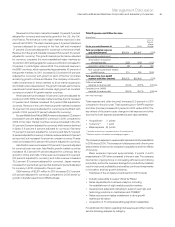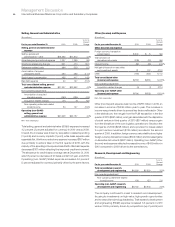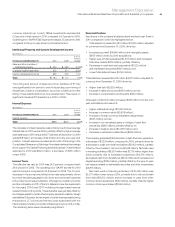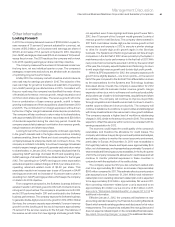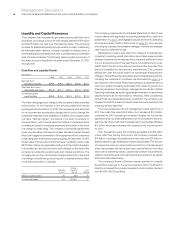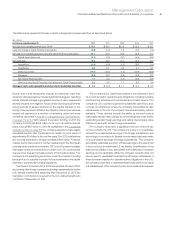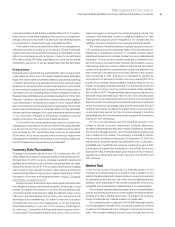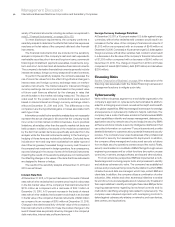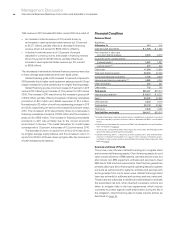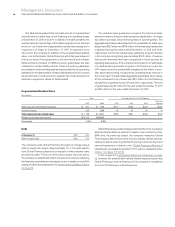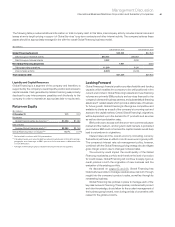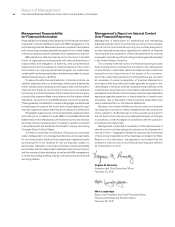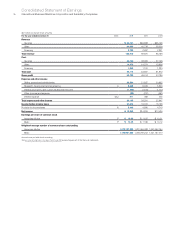IBM 2011 Annual Report Download - page 63
Download and view the complete annual report
Please find page 63 of the 2011 IBM annual report below. You can navigate through the pages in the report by either clicking on the pages listed below, or by using the keyword search tool below to find specific information within the annual report.
61
Management Discussion
International Business Machines Corporation and Subsidiary Companies
in actual receivable losses that are materially different from the estim-
ated reserve include sharp changes in the economy, or a significant
change in the economic health of a particular client that represents
a concentration in Global Financing’s receivables portfolio.
To the extent that actual collectibility differs from management’s
estimates currently provided for by 10 percent, Global Financing’s
segment pre-tax income and the company’s consolidated income
before income taxes would be higher or lower by an estimated
$35 million (using 2011 data), depending upon whether the actual
collectibility was better or worse, respectively, than the estimates.
Residual Value
Residual value represents the estimated fair value of equipment
under lease as of the end of the lease. Residual value estimates
impact the determination of whether a lease is classified as operating
or capital. Global Financing estimates the future fair value of leased
equipment by using historical models, analyzing the current market
for new and used equipment and obtaining forward-looking product
information such as marketing plans and technological innovations.
Residual value estimates are periodically reviewed and “other than
temporary” declines in estimated future residual values are recognized
upon identification. Anticipated increases in future residual values
are not recognized until the equipment is remarketed. Factors that
could cause actual results to materially differ from the estimates
include significant changes in the used-equipment market brought
on by unforeseen changes in technology innovations and any
resulting changes in the useful lives of used equipment.
To the extent that actual residual value recovery is lower than
management’s estimates by 10 percent, Global Financing’s segment
pre-tax income and the company’s consolidated income before
income taxes for 2011 would have been lower by an estimated
$104 million. If the actual residual value recovery is higher than
management’s estimates, the increase in income will be realized at
the end of lease when the equipment is remarketed.
Currency Rate Fluctuations
Changes in the relative values of non-U.S. currencies to the U.S.
dollar affect the company’s financial results and financial position.
At December 31, 2011, currency changes resulted in assets and
liabilities denominated in local currencies being translated into fewer
dollars than at year-end 2010. The company uses financial hedging
instruments to limit specific currency risks related to financing
transactions and other foreign currency-based transactions. Further
discussion of currency and hedging appears in note D, “Financial
Instruments,” on pages 96 to 100.
Foreign currency fluctuations often drive operational responses
that mitigate the simple mechanical translation of earnings. During
periods of sustained movements in currency, the marketplace and
competition adjust to the changing rates. For example, when pricing
offerings in the marketplace, the company may use some of the
advantage from a weakening U.S. dollar to improve its position
competitively, and price more aggressively to win the business,
essentially passing on a portion of the currency advantage to
its customers. Competition will frequently take the same action.
Consequently, the company believes that some of the currency-
based changes in cost impact the prices charged to clients. The
company also maintains currency hedging programs for cash
management purposes which mitigate, but do not eliminate, the
volatility of currency impacts on the company’s financial results.
The company translates revenue, cost and expense in its non-
U.S. operations at current exchange rates in the reported period.
References to “adjusted for currency” or “constant currency” reflect
adjustments based upon a simple constant currency mathematical
translation of local currency results using the comparable prior
period’s currency conversion rate. However, this constant currency
methodology that the company utilizes to disclose this information
does not incorporate any operational actions that management may
take in reaction to fluctuating currency rates. Based on the currency
rate movements in 2011, total revenue increased 7.1 percent as
reported and 3.4 percent at constant currency versus 2010. On a
pre-tax income basis, these translation impacts offset by the net
impact of hedging activities resulted in a theoretical maximum
(assuming no pricing or sourcing actions) increase of approximately
$600 million in 2011. The same mathematical exercise resulted in a
decrease of approximately $225 million in 2010. The company views
these amounts as a theoretical maximum impact to its as-reported
financial results. Considering the operational responses mentioned
above, movements of exchange rates, and the nature and timing of
hedging instruments, it is difficult to predict future currency impacts
on any particular period, but the company believes it could be
substantially less than the theoretical maximum given the competitive
pressure in the marketplace.
For non-U.S. subsidiaries and branches that operate in U.S.
dollars or whose economic environment is highly inflationary,
translation adjustments are reflected in results of operations. Generally,
the company manages currency risk in these entities by linking prices
and contracts to U.S. dollars. The company continues to monitor
the economic conditions in Venezuela. On December 30, 2010, the
official rate for essential goods was eliminated, with no change to
the SITME rate. The SITME rate remained constant throughout 2011.
Future gains or losses from devaluation of the SITME rate are not
expected to have a material impact given the size of the company’s
operations in Venezuela (less than 1 percent of total 2010 and
2011 revenue).
Market Risk
In the normal course of business, the financial position of the
company is routinely subject to a variety of risks. In addition to the
market risk associated with interest rate and currency movements
on outstanding debt and non-U.S. dollar denominated assets and
liabilities, other examples of risk include collectibility of accounts
receivable and recoverability of residual values on leased assets.
The company regularly assesses these risks and has established
policies and business practices to protect against the adverse effects
of these and other potential exposures. As a result, the company
does not anticipate any material losses from these risks.
The company’s debt, in support of the Global Financing business
and the geographic breadth of the company’s operations, contains
an element of market risk from changes in interest and currency
rates. The company manages this risk, in part, through the use of a


